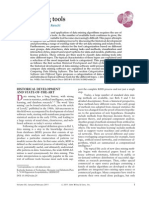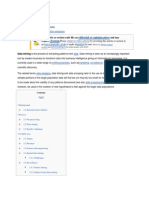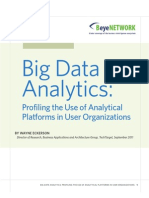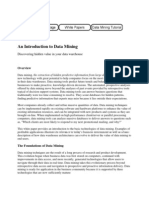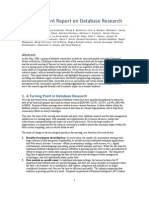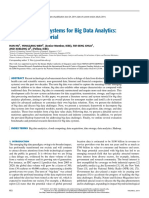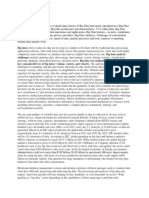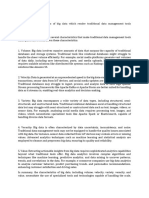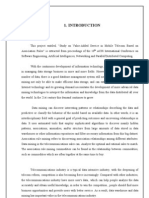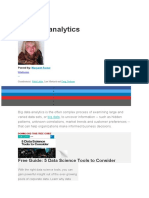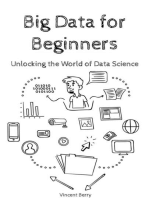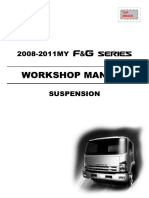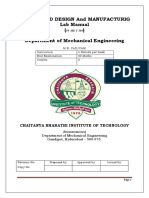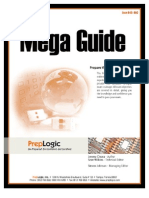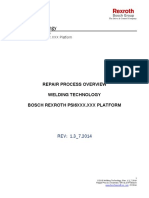Data Mining Tools
Data Mining Tools
Uploaded by
Musta MustaphaCopyright:
Available Formats
Data Mining Tools
Data Mining Tools
Uploaded by
Musta MustaphaCopyright
Available Formats
Share this document
Did you find this document useful?
Is this content inappropriate?
Copyright:
Available Formats
Data Mining Tools
Data Mining Tools
Uploaded by
Musta MustaphaCopyright:
Available Formats
Advanced Review
Data mining tools
Ralf Mikut and Markus Reischl
The development and application of data mining algorithms requires the use of powerful software tools. As the number of available tools continues to grow, the choice of the most suitable tool becomes increasingly difcult. This paper attempts to support the decision-making process by discussing the historical development and presenting a range of existing state-of-the-art data mining and related tools. Furthermore, we propose criteria for the tool categorization based on different user groups, data structures, data mining tasks and methods, visualization and interaction styles, import and export options for data and models, platforms, and license policies. These criteria are then used to classify data mining tools into nine different types. The typical characteristics of these types are explained and a selection of the most important tools is categorized. This paper is organized as follows: the rst section Historical Development and State-of-the-Art highlights the historical development of data mining software until present; the criteria to compare data mining software are explained in the second section Criteria for Comparing Data Mining Software. The last section Categorization of Data Mining Software into Different Types proposes a categorization of data mining software and introduces typical software tools for the different types. C 2011 John Wiley & Sons,
Inc. WIREs Data Mining Knowl Discov 2011 1 431443 DOI: 10.1002/widm.24
HISTORICAL DEVELOPMENT AND STATE-OF-THE-ART
ata mining has a long history, with strong roots in statistics, articial intelligence, machine learning, and database research.1, 2 The word data mining can be found relatively early, as in the article of Lovell,3 published in the 1980s. Advancements in this eld were accompanied by development of related software tools, starting with mainframe programs for statistical analysis in the early 1950s, and leading to a large variety of stand alone, client/server, and webbased software as todays service solution. Following the original denition given in Ref 1, data mining is a step in the knowledge discovery from databases (KDD) process that consists of applying data analysis and discovery algorithms to produce a particular enumeration of patterns (or models) across the data. In that same article, KDD is dened as the nontrivial process of identifying valid, novel, potentially useful, and ultimately understandable patterns in data. Sometimes, the wider KDD definition is used synonymously for data mining. This wider interpretation is especially popular in the context of software tools because most such tools supCorrespondence to: ralf.mikut.kit.edu Karlsruhe Institute of Technology, Hermann-von-Helmholtz-Platz 1, 76344 Eggenstein-Leopoldshafen, GERMANY DOI: 10.1002/widm.24
port the complete KDD process and not just a single step. Today, a large number of standard data mining methods are available, (see Refs 4 and 5 for detailed descriptions). From a historical perspective, these methods have different roots. One early group of methods was adopted from classical statistics: the focus was changed from the proof of known hypotheses to the generation of new hypotheses. Examples include methods from Bayesian decision theory, regression theory, and principal component analysis. Another group of methods stemmed from articial intelligence - like decision trees, rule-based systems, and others. The term machine learning includes methods such as support vector machines and articial neural networks. There are several different and sometimes overlapping categorizations; for example, fuzzy logic, articial neural networks, and evolutionary algorithms, which are summarized as computational intelligence.6 The typical life cycle of new data mining methods begins with theoretical papers based on inhouse software prototypes, followed by public or on-demand software distribution of successful algorithms as research prototypes. Then, either special commercial or open source packages containing a family of similar algorithms are developed or the algorithms are integrated into existing open source or commercial packages. Many companies have tried to promote their own stand alone packages, but only
Volume 1, September/October 2011
c 2011 John Wiley & Sons, Inc.
431
Advanced Review
wires.wiley.com/widm
few have reached notable market shares. The life cycle of some data mining tools is remarkably short. Typical reasons include internal marketing decisions and acquisitions of specialized companies by larger ones, leading to a renaming and integration of product lines. The largest commercial success stories resulted from the step-wise integration of data mining methods into established commercial statistical tools. Companies such as SPSS, founded in 1975 with precursors from 1968, or SAS, founded in 1976, have been offering statistical tools for mainframe computers since the 1970s. These tools were later adapted to personal computers and client/server solutions for larger customers. With the increasing popularity of data mining, algorithms such as articial neural networks or decision trees were integrated in the main products and specialized data mining companies such as Integrated Solutions Ltd. (acquired in 1998 by SPSS) were acquired to obtain access to data mining tools such as Clementine. During these periods, renaming of tools and company mergers played an important role in history; for example, the tool Clementine (SPSS) was renamed as PASW Modeler, and is now available as IBM SPSS Modeler after the acquisition of SPSS by IBM in 2009. In general, tools of this statistical branch are now very popular for the user groups in business application and applied research. Concurrently, many companies offering business intelligence products have integrated data mining solutions into their database products; one example is Oracle Data Mining (established in 2002). Many of these products are also a product of the acquisition and integration of specialized data mining companies. In 2008, the worldwide market for business intelligence (i.e., software and maintenance fees) was 7.8 billion USD, including 1.5 billion USD in socalled advanced analytics, containing data mining and statistics.7 This sector has grown 12.1% between 2007 and 2008, with large players including companies such as SAS (33.2%, tool: SAS Enterprise Miner), SPSS (14.3%, since 2009, an IBM company; tool: IBM SPSS Modeler), Microsoft (1.7%, tool: SQL Server Analysis Services), Teradata (1.5%, tool: Teradata Database, former name TeraMiner), and TIBCO (1.4%, tool: TIBCO Spotre). Open-source libraries have also become very popular since the 1990s. The most prominent example is Waikato Environment for Knowledge Analysis (WEKA), see Ref 8. WEKA started in 1994 as a C++ library, with its rst public release in 1996. In 1999, it was completely rebuilt as a JAVA package; since that time, it has been regularly updated. In addition, WEKA components have been integrated
in many other open-source tools such as Pentaho, RapidMiner, and KNIME. A large group of research prototypes are based on script-oriented mathematical programs such as MATLAB (commercial) and R (open source). Such mathematical programs were not originally focused on data mining, but contain many useful mathematical and visualization functions that support the implementation of data mining algorithms. Recently, graphical user interfaces such as those utilized for R (e.g., Rattle) and Matlab (e.g., Gait-CAD, Established in 2006) can be used as integration packages (INT) for many single, open-source algorithms. As the number of available tools continues to grow, the choice of one special tool becomes increasingly difcult for each potential user. This decisionmaking process can be supported by criteria for the categorization of data mining tools. Different categorizations of tools were proposed in Refs 912. The last two comprehensive criteria-based surveys date back to 1999, covering 43 software packages in Ref 9, and 2003, with 33 tools in Ref 12 (a regularly updated Excel table is available on request from the same author with 63 tools in 2009). In addition, smaller reviews have been published, containing 12 open-source tools,13 eight noncommercial tools,14 nine commercial tools,10 and ve commercial tools using benchmark datasets.15 In the past 1015 years, data mining has become a technology in its own right, is well established also in business intelligence (BI), and continues to exhibit steadily increasing importance in technology and life sciences sectors. For example, data mining was a key factor supporting methodological breakthroughs in genetics.16 It is a promising technology for future elds such as text mining and semantic search engines,17 learning in autonomous systemsas with humanoid robots18 and cars, chemoinformatics19 and others. Various standardization initiatives have been introduced for data mining processes, data and model interfacesas with Cross Industry Standard Process for Data Mining for industrial data mining,20 and approaches focused on clinical and biological applications.21 A survey of such initiatives is provided in Ref 22, and a large variety of standard data mining methods are described in comprehensive standard text books;4, 5 however, new methods, especially for data streams,23 extremely large datasets, graph mining,24, 25 text mining,17 and others have been proposed in the last few years. In the near future, methods for high-dimensional problems such as image retrieval26 and video mining27 will also be optimized and embedded into powerful tools.
432
c 2011 John Wiley & Sons, Inc.
Volume 1, September/October 2011
WIREs Data Mining and Knowledge Discovery
Data mining tools
T A B L E 1 Maximum Dimensions of Datasets for Different Types of Problems
Data Feature table Texts Time series Sequences Images Graphs 3D images Videos 3D videos Dim. 2 2 3 3 4 4 5 5 6 Structure for Each of the N Examples
s features (e.g., age and income) frequency of words or n-grams (vector-space approach) s time series with K time samples s sequences of length L (e.g., mass spectrograms and genes) s images with pixels s graphs with adjacency matrixes s images with pixels and slices s videos containing images with pixels and K time samples like videos, but with additional slices
Dim., maximum dimensionality; s, number of features; N, number of examples; K, number of samples in a time series. Lower dimensions of the dataset can occur for problems with only one feature s = 1 resp. one example ( N = 1).
CRITERIA FOR COMPARING DATA MINING SOFTWARE Survey
In the following, different criteria for comparison of data mining software are introduced. These criteria are based on user groups, data structures, data mining tasks and methods, import and export options, and license models. A detailed overview about the different tools is given later in this paper and as an Excel table in the additional material; however, some specic information about tools is discussed if a specic tool is unique to some aspects of the proposed criteria. The complete list of tools is provided toward the end of this paper.
integrate its own methods and compare these with existing methods. The necessary tools should contain many concurrent algorithms. Education: For education at universities, data mining tools should be very intuitive, with a comfortable interactive user interface, and inexpensive. In addition, they should allow the integration of in-house methods during programming seminars.
Data Structures
An important criterion is the dimensionality of the underlying raw data in the processed dataset (Table 1). The rst data mining applications were focused on handling datasets represented as two-dimensional feature tables. In this classical format, a dataset consists of a set of N examples (e.g., clients of an insurance company) with s features containing real values or usually integer-coded classes or symbols (e.g., income, age, number of contracts, and alike). This format is supported by nearly all existing tools. In some cases, the dataset can be sparse, with only a few nonzero features such as a list of s shopping items for N different customers. The computational and memory effort can be reduced if a tool exploits this sparse structure. Some structured datasets are characterized by the same dimensionality. As an example, sample documents in most text mining problems are represented by the frequency of words or so-called n-grams (a group of n subsequent characters in a document).28 The most prominent format having a higher dimensionality contains time series as elements, leading to dataset dimensions between one (i.e., only one example of a time series with K samples) and three (i.e., N different examples of s-dimensional vector time series with K samples). Typical tasks are forecasting of
User Groups
There are many different data mining tools available, which t the needs of quite different user groups: Business applications: This group uses data mining as a tool for solving commercially relevant business applications such as customer relationship management, fraud detection, and so on. This eld is mainly covered by a variety of commercial tools providing support for databases with large datasets, and deep integration in the companys workow. Applied research: A user group that applies data mining to research problems, for example, technology and life sciences. Here, users are mainly interested in tools with wellproven methods, a graphical user interface (GUI), and interfaces to domain-related data formats or databases. Algorithm development: Develops new data mining algorithms, and requires tools to both
Volume 1, September/October 2011
c 2011 John Wiley & Sons, Inc.
433
Advanced Review
wires.wiley.com/widm
future values, nding typical patterns in a time series or nding similar time series by clustering. The analysis of time series plays an import role in many different applications, including prediction of stock markets, forecasting of energy consumption and other markets, and quality supervision in production, and is also supported by most data mining tools. With a similar dimensionality, different kinds of structured data exist such as gene sequences (spatial structure), spectrograms or mass spectrograms (structured by frequencies or masses), and others. Only a few tools support these types of structured data explicitly, but some tools for time series analysis can be rearranged to cope with these problems. A more recent trend is the application of data mining methods for images and videos.26, 27 The main challenge is the handling of extremely large raw datasets, up to gigabytes and terabytes, caused by the high dimensionality of the examples. Typical applications are microscopic images in biology and medicine, camera-based sensors in quality control and robotics, biometrics, and security. Such datasets must be split into metadatawith links to image and video les handled in a main dataset and leswhich contain the main part of the data. Until now, these problems were normally solved using a combination of tools: the initial tool (e.g., ImageJ and ITK) would process the images or videos, resulting in segmented images and extracted features describing the segments; a second tool would solve data mining problems handling the extracted features as a classical table or time series. Another format leading to image-like dimensions includes graphs that can be represented as adjacency matrices, describing the connection between different nodes of a graph. Graph mining has powerful applications,24, 25 such as characterizing social networks and chemical structures; however, only a few such tools exist, including Pegasus and Proximity.
(c) regression: prediction of a real-valued output variable, including special cases of predicting future values in a time series out of recent or past values; unsupervised learning, without a known output variable in the dataset, including (a) clustering: nds and describes groups of similar examples in the data using crisp of fuzzy clustering algorithms; (b) association learning: nds typical groups of items that occur frequently together in examples; semisupervised learning, whereby the output variable is known only for some examples. Each of these tasks consists of a chain of lowlevel tasks. Furthermore, some low-level tasks can act as stand-alone tasks; for example, by identifying in a large dataset elements that possess a high similarity to a given example. Examples of such low-level tasks are: data cleaning (e.g., outlier detection); data ltering (e.g., smoothing of time series); feature extraction from time series, images, videos, and graphs (e.g., consisting of segmentation and segment description for images, characteristic values such as community structures in graphs); feature transformation (e.g., mathematical operations, including logarithms, dimension reduction by linear or nonlinear combinations by a principal component analysis, factor analysis or independent component analysis); feature evaluation and selection (e.g., by lter or wrapper methods); computation of similarities and detection of the most similar elements in terms of examples or features (e.g., by k-nearest-neighbormethods and correlation analysis); model validation (cross validation, bootstrapping, statistical relevance tests and complexity measures); model fusion (mixture of experts); and model optimization (e.g., by evolutionary algorithms). For almost all of these tasks, a large variety of classical statistical methodsincluding classiers
Tasks and Methods
The most important tasks in data mining are supervised learning, with a known output variable in the dataset, including (a) classication: class prediction, with the variable typically coded as an integer output; (b) fuzzy classication: with gradual memberships with values in-between 0 and 1 applied to the different classes;
434
c 2011 John Wiley & Sons, Inc.
Volume 1, September/October 2011
WIREs Data Mining and Knowledge Discovery
Data mining tools
using estimated probability density functions, factor analysis and others, and newer machine learning methodssuch as articial neural networks, fuzzy models, rough sets, support vector machines, decision trees, and random forests, are available. In addition, optimization models such as evolutionary algorithms can assist with the identication of model structures and parameters. The related methods are described in survey articles29 or textbooks4, 5 and are not summarized in this paper. Not all of the data mining methods are available in all software tools. The following list contains a subjective evaluation of the frequency with which specic methods are incorporated in the different tools: Frequent: classiers using estimated probability density functions, correlation analysis, statistical feature selection, and relevance tests; In many tools: decision trees, clustering, regression, data cleaning, data ltering, feature extraction, principal component analysis, factor analysis, advanced feature evaluation and selection, computation of similarities, articial neural networks, model cross validation, and statistical relevance tests; In some tools: fuzzy classication, association learning and mining frequent item sets, independent component analysis, bootstrapping, complexity measures, model fusion, support vector machines, k-nearest-neighbormethods, Bayesian networks, and learning of crisp rules; Infrequent: random forests30 (contained in Wafes, Random Forests, WEKA, and all of its derivatives), learning of fuzzy systems (contained in KnowledgeMiner, See5, and Gait-CAD), rough sets31 (in ROSETTA, and Rseslibs), and model optimization by evolutionary algorithms14 (in KEEL, ADaM, and D2K).
graphical user interface where the user selects function blocks or algorithms from a palette of choices, denes parameters, places them in a work area, and connects them to create complete data mining streams or workows; a good compromise, but difcult to handle for large workows. Mixtures of these forms arise if macros of menu items can be recorded for workows or if additional blocks in a workow can be implemented using a programming language. Automation (scripting) is extremely important for routine tasks, especially with large datasets, because the workload of the user is reduced. Almost all tools provide powerful visualization techniques for the presentation of data mining results; particularly tools for business application and applied research, which are able to generate complete reports containing the most important results in a readable form for users lacking explicit data mining skills. Interactive methods can support an explorative data analysis. An example is a method called brushing that enables the user to select specic data points in a gure or subsets of data (e.g., nodes of a decision tree) and highlight these data points in other plots.
Import and Export of Data and Models
The ease with which data and models can be imported and exported among different software tools plays a crucial role in the functionality of data mining tools. First, the data are normally generated and hosted from different sources such as databases or software associated with measurement devices. In business applications, interfaces to databases such as Oracle or any database supporting the Structured Query Language (SQL) standard are the most common means of importing data. Because almost all other nondata mining tools support export as text or excel les, formats such as CSV (comma separated values) are frequently used to import formats with data mining tools. In addition, almost all software have proprietary binary or textual les, and exchanges formats for data and models, e.g., Attribute-Relation File Format in WEKA (WEKA standard). In order to import and export developed models as components in other processes and systems, the XML-based standard PMML32 was developed by the Data Mining Group (http://www.dmg.org) and is supported by many companies such as IBM and SAS. Another standard initiative is the Object Linking and Embedding Database (OLEDB, sometimes written as OLEDB or OLE-DB) for data mining, an API (Application Programming Interface) designed
Interaction and Visualization
There are three main types of interaction between a user and a data mining tool: pure textual interface using a programming languagedifcult to handle, but easily automated; graphical interface with a menu structure easy to handle, but not so easily automated; and
Volume 1, September/October 2011
c 2011 John Wiley & Sons, Inc.
435
Advanced Review
wires.wiley.com/widm
by Microsoft to access different types of data stored in a uniform manner (http://msdn.microsoft.com/ en-us/library/ms146608.aspx). OLEDB is a set of interfaces implemented using the Component Object Model (COM). For data exchange among different tools, another initiative deals with Java Specication Requests for data mining: versions 1.0 (JSR 73, nal release in 2004: http://www.jcp.org/en/jsr/ detail?id=73) and 2.0 (JSR 247, public review as last activity in 2006: http://www.jcp.org/en/jsr/detail? id=247) dene an extensible Java API for data mining systems. The consortium includes many related companies, such as Oracle, SAS, SPSS (now IBM), SAP, and others; recent overviews can be found in Refs 33 and 34. Another interesting feature is the export of an executable runtime version of developed models. Often, they do not require a more expensive development license and can be run free of charge, or at least with a cheaper runtime license.
Platforms
Data mining tools can be subdivided into standalone and client/server solutions. Client/server solutions dominate, especially in products designed for business users. They are available for different platforms, including Windows, MAC OS, Linux, or special mainframe supercomputers. There is a growing number of JAVA-based systems that are platformindependent for users in research and applied research. Further expected trends are an increasing number of web interfaces providing data mining as SAAS (software as a service, with tools like Data Applied) and a stronger support of client/server-based data mining solutions on grids (tool ADaM, e.g., see, steps to a standardization in Ref 35); however, both trends have the potential risk of hurting privacy policies because the protection of data is difcult and many companies are very careful with sensitive data.
source software are faster bug xes and methodological improvements, potential for integration with other tools, the existence of developer and user communities, faster adoption of methods to other innovative applications, and the fair comparison of new data mining algorithms with alternative ones. These advantages attract mainly users of applied research, development, and education; however, open-source tools are beginning to migrate even into business user groups,37 particularly when additional commercial services such as training or maintenance are offered (e.g., Pentaho). The most popular type of open-source licenses is the GNU General Public License of the Free Software Foundation (GNU-GPL or GPL: http://www.fsf.org). It permits free redistribution, integration in other packages, and modication of the software as long as all subsequent users receive the same level of freedom (so-called copy left). This restriction guarantees that all software containing GNU-GPL components must be licensed under GNU-GPL. Weaker forms are licenses that are free for academic use, but not for business users. Mixed forms of licenses occur especially if opensource software is used to expand commercial tools such as Matlab. The Excel table (see, Section Supplementary Information) lists 195 recent tools (119 commercial tools, 67 open source tools, and nine tools with mixed license models).
CATEGORIZATION OF DATA MINING SOFTWARE INTO DIFFERENT TYPES
Following the criteria from the previous section, different types of similar data mining tools can be found. The typical characteristics of these types are explained in this section. Matching of the different types and user groups and the number of recent tools are summarized in Table 2. In addition, for commercial data mining tools, related tools and their group membership are summarized in different tables for commercial (Tables 3 and 4), free, and open-source data mining tools (Table 5). In these tables, very popular tools are marked in bold. The popularity was measured by the 20 most frequently used tools for real projects from Data Mining/Analytic Tools Used Poll 2010 of KDnuggets with 912 voters (http://www.kdnuggets.com/polls/2010/datamining-analytics-tools.html); [top 10 tools were RapidMiner, R, Excel (here ignored), KNIME, Pentaho/WEKA, SAS, MATLAB,
Licenses
There exists a wide variety of data mining tools with commercial and open-source licenses. This is particularly true in the business application user group, where commercial software is very attractive due to high software stability, good coupling with other commercial tools for data warehouses, included software maintenance, and the possibility of user training for sophisticated topics. For all other user groups, there is a strong trend toward open-source software, but different types of licenses exist for this (e.g., see, survey in Ref 36). The main advantages of open-
436
c 2011 John Wiley & Sons, Inc.
Volume 1, September/October 2011
WIREs Data Mining and Knowledge Discovery
Data mining tools
T A B L E 2 Matching Between Different User Groups and Tool Types with Number of Recent Tools in the Excel Table (see, Section Supplementary Information, tools belonging to two
IBM SPSS Statistics, IBM SPSS Modeler, and Microsoft SQL Server]; all main products of vendors with more than 1% market share in the section Advanced Analytics Tools from Ref 7; and the most popular image processing tools (ITK and ImageJ) from the authors own experience to cover this eld. In this paper, the following nine types are proposed: Data mining suites (DMS) focus largely on data mining and include numerous methods. They support feature tables and time series, while additional tools for text mining are sometime available. The application focus is wide and not restricted to a special application eld, such as business applications; however, coupling to business solutions, import and export of models, reporting, and a variety of different platforms are nonetheless supported. In addition, the producers provide services for adaptation of the tools to the workows and data structures of the customer. DMS is mostly commercial and rather expensive, but some open-source tools such as RapidMiner exist. Typical examples include IBM SPSS Modeler, SAS Enterprise Miner, Alice dIsoft, DataEngine, DataDetective, GhostMiner, Knowledge Studio, KXEN, NAG Data Mining Components, Partek Discovery Suite, STATISTICA, and TIBCO Spotre. Business intelligence packages (BIs) have no special focus to data mining, but include basic data mining functionality, especially for statistical methods in business applications. BIs are often restricted to feature tables and time series, large feature tables are supported. They have a highly developed reporting functionality and good support for education, handling, and adaptation to the workows of the customer. They are characterized by a strong focus on database coupling, and are implemented via a client/server architecture. Most BI softwares are commercial (IBM Cognos 8 BI, Oracle Data Mining, SAP Netweaver Business Warehouse, Teradata Database, DB2 Data Warehouse from IBM, and PolyVista), but a few open-source solutions exist (Pentaho). Mathematical packages (MATs) have no special focus on data mining, but provide a
Solutions 19 Research Prototypes 17 Specialities 56 Data Mining Libraries 20 Extensions 10 Integration Packages 8 Mathematical Packages 5 Business Intelligence Packages 16
+
Evaluation, +: especially useful, 0: less useful, : not useful.
Data Mining Suites 46 categories are counted twice) Types Number of Recent Tools
Business applications Applied research Algorithm development Education
+ + +
+ + 0
0 + + 0
0 0 +
0 +
0 0 0 +
0 +
0 + 0
Volume 1, September/October 2011
c 2011 John Wiley & Sons, Inc.
437
Advanced Review
wires.wiley.com/widm
T A B L E 3 List of Commercial Tools (Part 1)
Tool ADAPA (Zementis) Alice (dIsoft) Bayesia Lab C5.0 CART Data Applied DataDetective DataEngine Datascope DB2 Data Warehouse DeltaMaster Forecaster XL GhostMiner IBM Cognos 8 BI IBM SPSS Modeler IBM SPSS Statistics iModel InfoSphere Warehouse JMP KnowledgeMiner KnowledgeStudio KXEN Magnum Opus MATLAB MATLAB Neural Network Toolbox Model Builder ModelMAX
Very popular tools are marked in bold letters.
Type DMS DMS SPEC SPEC SPEC DMS DMS DMS DMS BI BI EXT DMS BI DMS MAT DMS BI DMS SPEC DMS DMS SPEC MAT EXT DMS SOL
Link www.zementis.com www.alice-soft.com www.bayesia.com www.rulequest.com www.salford-systems.com data-applied.com www.sentient.nl/?dden www.dataengine.de www.cygron.hu www.ibm.com/software/data/infosphere/warehouse www.bissantz.com/deltamaster www.alyuda.com www.fqs.pl/business intelligence/products/ghostminer www.ibm.com/software/data/cognos/data-mining-tools.html www.spss.com/software/modeling/modeler www.spss.com/software/statistics www.biocompsystems.com/products/imodel www.ibm.com/software/data/infosphere/warehouse www.jmpdiscovery.com www.knowledgeminer.net www.angoss.com www.kxen.com www.giwebb.com www.mathworks.com www.mathworks.com www.co.com www.asacorp.com/products/mmxover.jsp
large and extendable set of algorithms and visualization routines. They support feature tables, time series, and have at least import formats for images. The user interaction often requires programming skills in a scripting language. MATs are attractive to users in algorithm development and applied research because data mining algorithms can be rapidly implemented, mostly in the form of extensions (EXT) and research prototypes (RES). MAT packages exist as commercial (MATLAB and R-PLUS) or open-source tools (R, Kepler). In principle, table calculation software such as Excel may also be categorized here, but it is not included in this paper. Most tools are available for different platforms but have weaknesses in database coupling. Integration packages (INTs) are extendable bundles of many different open-source algorithms, either as stand-alone software (mostly
based on Java; as KNIME, the GUI-version of WEKA, KEEL, and TANAGRA) or as a kind of larger extension package for tools from the MAT type (such as Gait-CAD, PRTools for MATLAB, and RWEKA for R). Import and export support standard formats, but database support is quite weak. Most tools are available for different platforms and include a GUI. Mixtures of license models occur if open-source integration packages are based on commercial tools from the MAT type. With these characteristics, the tools are attractive to algorithm developers and users in applied research due to expandability and rapid comparison with alternative tools, and due to easy integration of application-specic methods and import options. EXT are smaller add-ons for other tools such as Excel, Matlab, R, and so forth, with limited but quite useful functionality. Here, only a few data mining algorithms are implemented
438
c 2011 John Wiley & Sons, Inc.
Volume 1, September/October 2011
WIREs Data Mining and Knowledge Discovery
Data mining tools
T A B L E 4 List of Commercial Tools (Part 2)
Tool Molegro Data Modeler NAG Data Mining Components NeuralWorks Predict Neurofusion Neuroshell Oracle Data Mining (ODM) Partek Discovery Suite Partek Genomics Suite PolyAnalyst PolyVista Random Forests RapAnalyst R-PLUS SAP Netweaver Business Warehouse (BW) SAS Enterprise Miner See5 SPAD Data Mining SQL Server Analysis Services STATISTICA SuperQuery Teradata Database Think Enterprise Data Miner (EDM) TIBCO Spotre Unica PredictiveInsight WizRule and WizWhy XAfnity
Very popular tools are marked in bold letters.
Type SOL LIB SPEC LIB SPEC DMS DMS SOL DMS BI SPEC SPEC MAT BI DMS SPEC DMS DMS DMS DMS BI DMS DMS DMS SPEC SPEC
Link www.molegro.com www.nag.co.uk/numeric/DR/DRdescription.asp www.neuralware.com/products.jsp www.alyuda.com www.neuroshell.com www.oracle.com/technology/products/bi/odm/index.html www.partek.com/software www.partek.com/software www.megaputer.com/polyanalyst.php www.polyvista.com www.salford-systems.com www.raptorinternational.com/rapanalyst.html www.experience-rplus.com www.sap.com/platform/netweaver/components/businesswarehouse www.sas.com/products/miner www.rulequest.com eng.spadsoft.com www.microsoft.com/sql www.statsoft.com/products/data-mining-solutions/G259 www.azmy.com www.teradata.com www.thinkanalytics.com spotre.tibco.com www.unica.com www.wizsoft.com www.exclusiveore.com
such as articial neural networks for Excel (Forecaster XL and XLMiner) or MATLAB (Matlab Neural Networks Toolbox). There are commercial or open-source versions, but licenses for the basic tools must also be available. The user interaction is the same as for the basic tool, for example, by using a programming language (MATLAB) or by embedding the extension in the menu (Excel). Data mining libraries (LIBs) implement data mining methods as a bundle of functions. These functions can be embedded in other software tools using an Application Programming Interface (API) for the interaction between the software tool and the data mining functions. A graphical user interface is missing, but some functions can support the integration of specic visualization tools. They are often written in JAVA or C++ and the solutions are platform independent. Open source examples are WEKA (Java-based), MLC++ (C++ based), JAVA Data Min-
ing Package, and LibSVM (C++ and JAVAbased) for support vector machines. A commercial example is Neurofusion for C++, whereas XELOPES (Java, C++, and C ) uses different license models. LIB tools are mainly attractive to users in algorithm development and applied research, for embedding data mining software into larger data mining software tools or specic solutions for narrow applications. Specialties (SPECs) are similar to DMS tools, but implement only one special family of methods such as articial neural networks. They contain many elaborate visualization techniques for such methods. SPECs are rather simple to handle as compared with other tools, which eases the use of such tools in education. Examples are CART for decision trees, Bayesia Lab for Bayesian networks, C5.0, WizRule, Rule Discovery System for rule-based systems, MagnumOpus for association analysis, and JavaNNS, Neuroshell,
Volume 1, September/October 2011
c 2011 John Wiley & Sons, Inc.
439
Advanced Review
wires.wiley.com/widm
T A B L E 5 List of Free and Open-Source Tools
Tool ADaM CellProlerAnalyst D2K Gait-CAD GATE GIFT Gnome Data Mine Tools Himalaya ImageJ ITK JAVA Data Mining Package JavaNNS KEEL Kepler KNIME LibSVM MEGA MLC++ Orange Pegasus Pentaho Proximity PRTools R RapidMiner Rattle ROOT ROSETTA Rseslibs Rule Discovery System RWEKA TANAGRA Wafes WEKA XELOPES Library XLMiner
Very popular tools are marked in bold letters. , Commercial tools with free licenses for academic use.
Type LIB SOL DMS INT SOL RES DMS RES SOL SOL LIB SPEC INT MAT INT LIB SOL LIB LIB RES BI SPEC EXT MAT DMS INT LIB SPEC RES SPEC INT INT LIB DMS, LIB LIB EXT
Link datamining.itsc.uah.edu/adam www.cellproler.org/index.htm alg.ncsa.uiuc.edu sourceforge.net/projects/gait-cad gate.ac.uk/download www.gnu.org/software/gift www.togaware.com/datamining/gdatamine himalaya-tools.sourceforge.net rsbweb.nih.gov/ij www.itk.org sourceforge.net/projects/jdmp www.ra.cs.uni-tuebingen.de/software/JavaNNS/welcome e.html www.keel.es kepler-project.org www.knime.org www.csie.ntu.edu.tw/ cjlin/libsvm www.megasoftware.net/m distance.html www.sgi.com/tech/mlc www.ailab.si/orange www.cs.cmu.edu/ pegasus sourceforge.net/projects/pentaho kdl.cs.umass.edu/proximity/index.html www.prtools.org www.r-project.org www.rapidminer.com rattle.togaware.com root.cern.ch/root www.lcb.uu.se/tools/rosetta/index.php logic.mimuw.edu.pl/ rses www.compumine.com cran.r-project.org/web/packages/RWeka/index.html eric.univ-lyon2.fr/ ricco/tanagra/en/tanagra.html wafes.sourceforge.net sourceforge.net/projects/weka www.prudsys.de/en/technology/xelopes www.resample.com/xlminer
NeuralWorks Predict, RapAnalyst for articial neural networks. RES are usually the rstand not always stableimplementations of new and innovative algorithms. They contain only one or a few algorithms with restricted graphical support and without automation support. Import and export functionality is rather restricted and database coupling is missing or weak. RES tools are mostly opensource. They are mainly attractive to users in algorithm development and applied research, specically in
very innovative elds. Examples are GIFT for content-based image retrieval, Himalaya for mining maximal frequent item sets, sequential pattern mining and scalable linear regression trees, Rseslibs for rough sets, and Pegasus for graph mining. Early versions of todays popular tools such as WEKA and RapidMiner started in this category and shifted later to other categories as DMS. Solutions (SOLs) describe a group of tools that are customized to narrow application elds such as text mining (GATE), image
440
c 2011 John Wiley & Sons, Inc.
Volume 1, September/October 2011
WIREs Data Mining and Knowledge Discovery
Data mining tools
processing (ITK, ImageJ), drug discovery (Molegro Data Modeler), image analysis in microscopy (CellProlerAnalyst), or mining gene expression proles (Partek Genomics Suite, MEGA). The advantage of these solutions is the excellent support of domainspecic feature extraction techniques, evaluation measures, visualizations, and import formats. The level of data mining methods ranges from rather weak support (particularly in image processing) to highly developed algorithms. In some cases, more general tools from types DMS or INT also support specic domains (KNIME, Gait-CAD for peptide chemoinformatics). There are many commercial and open-source solutions. A large variety of tools actually requires a fuzzy categorization with gradual memberships to different types. Examples are tools including a set of different algorithms (LIB) with an additional GUI acting as an INT, DMS, including special methods for narrow application elds and others. In these cases, a main type was assigned and the other fuzzy memberships are discussed in the Excel table in the additional material section. The following kinds of tools were not included in the comparison: nonavailable software (e.g., owing to company mergers or stopped developments) is only listed in the Excel table in the additional material, software for the handling of data warehouses without explicit focus on data mining, software for the manual design and application of rule-based systems, software for table calculation with a focus to ofce users, and customized solutions for very narrow elds.
ferent types of tools are presented: DMS, BIs, MATs, INT, EXT, SPECs, RES, LIBs, and SOLs. They vary in many different characteristics, such as intended user groups, possible data structures, implemented tasks and methods, interaction styles, import and export capabilities, platforms and license policies are variable. Recent tools are able to handle large datasets with single features, time series, and even unstructured data-like texts; however, there is a lack of powerful and generalized mining tools for multidimensional datasets such as images and videos.
SUPPLEMENTARY INFORMATION
An additional Excel table contains a list of 269 tools (195 recent and 74 historical tools, version from July 22, 2010). For each tool, the following information is available: toolbox name, company or group (with the term various for open-source projects without an explicit developer), categorization into types with abbreviations for Research Prototypes (RES), Data Mining Libraries (LIB), Business Intelligence Packages (BI), Data Mining Software (DMS), Specialties (SPEC), Mathematical Packages (MAT), Extensions (EXT), Integration Packages (INT), Solutions (SOL), Giraud-Carrier: marking the covering by the Excel table in Ref 12 (Stand: February 3, 2010) with the values 1 (included in a detailed categorization), 1 (excluded), empty eld: not mentioned, remarks, web link, activity: 1 (relevant tool, included in the comparison), 0 (less relevant), 1 (not available). license: OS, open source; CO, commercial; CO/OS, different versions available. There are a number of regularly updated web resources with link lists, but lacking a criteria-based comparison of the tools. The most important web resources are: KDnuggets: http://www.kdnuggets.com/ software/suites.html, including regular polls to identify the most frequently used tools,
CONCLUSION
Many advanced tools for data mining are available either as open-source or commercial software. They cover a wide range of software products, from comfortable problem-independent data mining suites, to business-centered data warehouses with integrated data mining capabilities, to early research prototypes for newly developed methods. In this paper, nine dif-
Volume 1, September/October 2011
c 2011 John Wiley & Sons, Inc.
441
Advanced Review
wires.wiley.com/widm
The Data Mine: http://www.the-data-mine. com/bin/view/software The Open Directory Project: http://www. dmoz.org/Computers/Software/Databases/ Data Mining Sourceforge (very popular platform for opensource solutions, search for data mining to
nd data mining tools hosted at Sourceforge): http://sourceforge.net/ Kernel Machines (especially to get a list of software to support vector machines): http://www.kernel-machines.org/software Tools for Bayesian Networks: www.cs. helsinki./research/cosco/Bnets.
ACKNOWLEDGMENTS
The authors thank C. Giraud-Carrier for a copy of an Excel table containing a large set of data mining tools, the anonymous reviewers for many comments and suggestions, and R. A. Klady for the critical proofreading of the manuscript.
REFERENCES
1. Fayyad U, Piatetsky-Shapiro G, Smyth P. From data mining to knowledge discovery in databases. AI Mag 1996, 17:3754. 2. Smyth P. Data mining: Data analysis on a grand scale? Stat Methods Med Res 2000, 9:309327. 3. Lovell MC. Data mining. Rev Econ Stat 1983, 65:1 11. 4. Han J, Kamber M. Data Mining: Concepts and Techniques. San Francisco: Morgan Kaufmann; 2006. 5. Hastie T, Tibshirani R, Friedman J. The Elements of Statistical Learning: Data Mining, Inference, and Prediction. New York: Springer; 2008. 6. Engelbrecht AP. Computational Intelligence - An Introduction. Chichester: John Wiley; 2007. 7. Vesset D, McDonough B. Worldwide business intelligence tools 2008 vendor shares, IDC Competitive Analysis Report (2009). 8. Frank E, Hall M, Holmes G, Kirkby R, Pfahringer B, Witten I. Weka: A machine learning workbench for data mining. Data Mining and Knowledge Discovery Handbook: A Complete Guide for Practitioners and Researchers. New York: Springer; 2005, 13051314. 9. Goebel M. A survey of data mining and knowledge discovery software tools, ACM SIGKDD Explorations. Newsletter 1999, 1:2033. 10. Wang J, Hu X, Hollister K, Zhu D. A comparison and scenario analysis of leading data mining software. Int J Knowl Manage 2008, 4:1734. 11. Wang J, Chen Q, Yao J. Data mining software. In: Tomei L, ed., Encyclopedia of Information Technology Curriculum Integration. Hershey, PA: Information Science Publishing; 2008, 173178. 12. Giraud-Carrier C, Povel O. Characterising data mining software. Intell Data Anal 2003, 7:181192. 13. Chen X, Ye Y, Williams G, Xu X. A survey of open source data mining systems, Lecture Notes in Computer Science 2007, 4819:314. 14. Alcala-Fdez J, Sanchez L, Garca S, del Jesus M, Ventura S, Garrell J, Otero J, Romero C, Bacardit J, Rivas V, et al. KEEL: A software tool to assess evolutionary algorithms for data mining problems. Soft Comput 2009, 13:307318. 15. Haughton D, Deichmann J, Eshghi A, Sayek S, Teebagy N, Topi H. A review of software packages for data mining. Am Stat 2003, 57:290310. 16. Barrett T, Troup D, Wilhite S, Ledoux P, Rudnev D, Evangelista C, Kim I, Soboleva A, Tomashevsky M, Edgar R. NCBI GEO: Mining tens of millions of expression prolesdatabase and tools update. Nucleic acids Res 2007, D760. 17. Weiss S. Text mining: predictive methods for analyzing unstructured information. New York: Springer-Verlag; 2005. 18. Dillmann R. Teaching and learning of robot tasks via observation of human performance. Rob Auton Syst 2004, 47:109116. 19. Leach A, Gillet V. An Introduction to Chemoinformatics. Springer; 2007. 20. Shearer C. The CRISP-DM model: The new blueprint for data mining. J Data Warehousing 2000, 5: 1322. 21. Mikut R, Reischl M, Burmeister O, Loose T. Data mining in medical time series. Biomed Tech 2006, 51:288 293.
442
c 2011 John Wiley & Sons, Inc.
Volume 1, September/October 2011
WIREs Data Mining and Knowledge Discovery
Data mining tools
22. Grossman R, Hornick M, Meyer G. Data mining standards initiatives. Commun ACM 2002, 45:61. 23. Muthukrishnan S. Data Streams: Algorithms and Applications. Hanover, MA: Now Publishers Inc.; 2005. 24. Chakrabarti D, Faloutsos C. Graph mining: laws, generators, and algorithms. ACM Comput Surv (CSUR) 2006, 38:169. 25. Borgelt C. Graph mining: An overview. Proc., 19. Workshop Computational Intelligence. Karlsruhe, Germany: KIT Scientic Publishing; 2009, 189203. 26. Datta R, Joshi D, Li J, Wang J. Image retrieval: Ideas, inuences, and trends of the new age. ACM Comput Surv (CSUR) 2008, 40:160. 27. Zhu X, Wu X, Elmagarmid A, Feng Z, Wu L. Video data mining: Semantic indexing and event detection from the association perspective. IEEE Trans Knowl Data Eng 2005, 17:665677. 28. Damashek M. Gauging similarity with n-Grams: Language-independent categorization of text. Science 1995, 267:843848. 29. Jain AK, Duin RPW, Mao J. Statistical pattern recognition: A review. IEEE Trans Pattern Anal Mach Intell 2000, 22:436. 30. Breiman L. Random forests. Mach Learn 2001, 45:5 32.
31. Pawlak Z. Rough sets and intelligent data analysis. Inf Sci 2002, 147:112. 32. Pechter R. Whats PMML and whats new in PMML 4.0?, ACM SIGKDD Explorations. Newsletter 2009, 11:1925. 33. Hornick M, Marcad E, Venkayala S. Java Data e Mining: Strategy, Standard, and Practice: A Practical Guide for Architecture, Design, and Implementation. San Francisco: Morgan Kaufmann Publishers Inc.; 2006. 34. Anand S, Grobelnik M, Herrmann F, Hornick M, Lingenfelder C, Rooney N, Wettschereck D. Knowledge discovery standards. Articial Intelligence Review 2007, 27:2156. 35. Cannataro M, Congiusta A, Pugliese A, Talia D, Truno P. Distributed data mining on grids: Services, tools, and applications. IEEE Trans Syst Man Cybern B Cybern 2004, 34:24512465. 36. Sonnenburg S, Braun M, Ong C, Bengio S, Bottou L, Holmes G, LeCun Y, Muller K, Pereira F, Rasmussen C, et al. The need for open source software in machine learning. J Mach Learn Res 2007, 8:24432466. 37. Bitterer A. Open-source business intelligence tool production deployments will grow ve-fold through 2010, Gartner RAS Research Note G00171189 (2009).
Volume 1, September/October 2011
c 2011 John Wiley & Sons, Inc.
443
You might also like
- Data Mining ToolsDocument13 pagesData Mining ToolsMiguel Angel Riaño TrujilloNo ratings yet
- Web Intelligence: What Is Webintelligence?Document25 pagesWeb Intelligence: What Is Webintelligence?Rajesh RathodNo ratings yet
- A Survey On Data MiningDocument4 pagesA Survey On Data MiningInternational Organization of Scientific Research (IOSR)No ratings yet
- Magic Quadrant For Data Science-PlatformsDocument37 pagesMagic Quadrant For Data Science-PlatformsDhruv AgarwalNo ratings yet
- Data Mining: Encyclopedic Style NeutralDocument12 pagesData Mining: Encyclopedic Style NeutralAlex LeeNo ratings yet
- BDBIDocument82 pagesBDBIMariyaNo ratings yet
- 1) Data-sci Chapter-1Document17 pages1) Data-sci Chapter-1snehalsameerjadhavNo ratings yet
- AST-0060878 Wayne Eckerson Research Report Big Data Analytics FinalDocument57 pagesAST-0060878 Wayne Eckerson Research Report Big Data Analytics FinalIvan DyachokNo ratings yet
- C - B D A - A S C R F D: Loud Based IG ATA Nalytics Urvey of Urrent Esearch and Uture IrectionsDocument12 pagesC - B D A - A S C R F D: Loud Based IG ATA Nalytics Urvey of Urrent Esearch and Uture Irectionsprayas jhariyaNo ratings yet
- Unit-1Document11 pagesUnit-1itskuldeepitskuldeep2No ratings yet
- Gartner Reprint AIMLDocument50 pagesGartner Reprint AIMLferozdmNo ratings yet
- Cloud Computing Literature ReviewDocument7 pagesCloud Computing Literature Reviewea0kvft0100% (1)
- From Data Mining To Knowledge Discovery in DatabaseDocument18 pagesFrom Data Mining To Knowledge Discovery in Databasekistidi33100% (1)
- New Directions in AnalyticsDocument14 pagesNew Directions in AnalyticsKannan RamaswamyNo ratings yet
- Weka TutorialDocument53 pagesWeka TutorialVikas BansalNo ratings yet
- ProposalDocument5 pagesProposalOmotayo Samuel VictorNo ratings yet
- Software and Fieldwork Friese in Hobbs-Ch19 PDFDocument26 pagesSoftware and Fieldwork Friese in Hobbs-Ch19 PDFChicoUiobiNo ratings yet
- Kushalproject 1Document77 pagesKushalproject 1Gamers worldNo ratings yet
- 1st Unit DADocument7 pages1st Unit DAAshwinNo ratings yet
- Data Mining, Cobol, MemoryDocument54 pagesData Mining, Cobol, Memorypitchrks19841No ratings yet
- Bhabesh - Chapter 2Document34 pagesBhabesh - Chapter 2raj.kangkanNo ratings yet
- An Introduction To Data Mining: Discovering Hidden Value in Your Data WarehouseDocument18 pagesAn Introduction To Data Mining: Discovering Hidden Value in Your Data WarehouseIshrat MotiwalaNo ratings yet
- Data Mining Past Present and FutureDocument6 pagesData Mining Past Present and FuturesaajithNo ratings yet
- The Claremont Report On Database ResearchDocument11 pagesThe Claremont Report On Database ResearchvthungNo ratings yet
- Datasist: A Python-Based Library For Easy Data Analysis, Visualization and ModelingDocument17 pagesDatasist: A Python-Based Library For Easy Data Analysis, Visualization and ModelingSalman AbidNo ratings yet
- BigDataAnalyticsDocument36 pagesBigDataAnalyticsdeepak1892100% (1)
- Toward Scalable Systems For Big Data Analytics: A Technology TutorialDocument36 pagesToward Scalable Systems For Big Data Analytics: A Technology TutorialAgus SuryantoNo ratings yet
- The Influence of Big Data Analytics in The IndustryDocument15 pagesThe Influence of Big Data Analytics in The IndustrymikhailovaelyaNo ratings yet
- Data Mining Capital IqDocument78 pagesData Mining Capital IqGamers worldNo ratings yet
- UNIT 2 Notes by ARUN JHAPATEDocument22 pagesUNIT 2 Notes by ARUN JHAPATEAnkit “अंकित मौर्य” MouryaNo ratings yet
- 04 Data Mining-ApplicationsDocument6 pages04 Data Mining-ApplicationsRaj EndranNo ratings yet
- Tugas Praktikum MetstatDocument99 pagesTugas Praktikum MetstatAnggraini FabrilaNo ratings yet
- Ds4015 Big Data Analytics QBDocument155 pagesDs4015 Big Data Analytics QBBARATHNo ratings yet
- Research Paper - Reading MaterialsDocument15 pagesResearch Paper - Reading MaterialssplokbovNo ratings yet
- Data Mining and Business IntelligenceDocument41 pagesData Mining and Business IntelligenceAnonymous m13yWyGyNo ratings yet
- Big Data - 1544723672 PDFDocument15 pagesBig Data - 1544723672 PDFAbhishek R.PNo ratings yet
- Big Data - 1544723612 PDFDocument15 pagesBig Data - 1544723612 PDFAbhishek R.PNo ratings yet
- 1 Res PDFDocument15 pages1 Res PDFAbhishek R.PNo ratings yet
- Vickie Data AnalyticsDocument9 pagesVickie Data AnalyticsEleonor Victoria AliazarNo ratings yet
- Big Data Unit IDocument8 pagesBig Data Unit IManish NagarNo ratings yet
- Unit 1 NotesDocument25 pagesUnit 1 NotesSENTHAMIZH VANI A PNo ratings yet
- GradientFlow Trends Report 2022Document16 pagesGradientFlow Trends Report 2022Alberto RoblesNo ratings yet
- Big Data ChatgptDocument8 pagesBig Data Chatgptvenkatesh sharmaNo ratings yet
- Data Mining - First Page PDFDocument20 pagesData Mining - First Page PDFPriya VarmaNo ratings yet
- Machine Learning and Cloud Computing: Survey of Distributed and Saas SolutionsDocument13 pagesMachine Learning and Cloud Computing: Survey of Distributed and Saas SolutionssfarithaNo ratings yet
- Introduction To Data MiningDocument8 pagesIntroduction To Data MiningIhsan baustNo ratings yet
- Big Data Analytics: A Literature Review Paper: Abstract. in The Information Era, Enormous Amounts of Data Have BecomeDocument14 pagesBig Data Analytics: A Literature Review Paper: Abstract. in The Information Era, Enormous Amounts of Data Have BecomeDolphingNo ratings yet
- ChandrakanthDocument64 pagesChandrakanthSuresh Dhamathoti100% (1)
- A Review of Big Data AnalyticsDocument15 pagesA Review of Big Data AnalyticsOgbodu Ejiro DesmondNo ratings yet
- Big Data Analytics: Free Guide: 5 Data Science Tools To ConsiderDocument8 pagesBig Data Analytics: Free Guide: 5 Data Science Tools To ConsiderKeemeNo ratings yet
- Data AnalyticsDocument69 pagesData Analyticsmeghanakumari105No ratings yet
- Spark PDFDocument10 pagesSpark PDFNew MahoutsukaiNo ratings yet
- 2 Big Data AnalysisDocument10 pages2 Big Data AnalysisAnshi AgrawalNo ratings yet
- Big Data Unit 1 Notes - 240311 - 100703Document15 pagesBig Data Unit 1 Notes - 240311 - 100703vishalsy301No ratings yet
- Comparative Analysis of Open Source Business Intelligence Tools For Crime Data AnalyticsDocument6 pagesComparative Analysis of Open Source Business Intelligence Tools For Crime Data AnalyticsSachin N GudimaniNo ratings yet
- Introduction to Data Platforms: How to leverage data fabric concepts to engineer your organization's data for today's cloud-based digital worldFrom EverandIntroduction to Data Platforms: How to leverage data fabric concepts to engineer your organization's data for today's cloud-based digital worldNo ratings yet
- AA LESSON PLAN AIS655 - OCT 2020 - Student - Update18oct2020Document3 pagesAA LESSON PLAN AIS655 - OCT 2020 - Student - Update18oct2020Firdaus YahyaNo ratings yet
- Sharmar5@indianoil - In: 5) Copy of 5 Semester Mark Sheet For B. Tech. or 1 Semester For MBADocument2 pagesSharmar5@indianoil - In: 5) Copy of 5 Semester Mark Sheet For B. Tech. or 1 Semester For MBARahulBhardwajNo ratings yet
- 02 Suspension MGSUS-WE-0871 9thDocument130 pages02 Suspension MGSUS-WE-0871 9thSyaiful Efendi100% (2)
- Simple Mods For StompboxesDocument4 pagesSimple Mods For StompboxesCarlos Ramirez100% (1)
- Graduate Program VolvoDocument2 pagesGraduate Program VolvoMAYA ERAPPANo ratings yet
- GF1061 Transformer Test GFUVEDocument3 pagesGF1061 Transformer Test GFUVEAkbar SyawaludinNo ratings yet
- Ankur AgarwalDocument4 pagesAnkur Agarwalmiss_jyoti_kapoorNo ratings yet
- Hospital Case Study FlexsimDocument2 pagesHospital Case Study FlexsimMano KanthanathanNo ratings yet
- RFID DOD Tag StandardDocument6 pagesRFID DOD Tag StandardIsmaelNo ratings yet
- ABNT NBR 6354 2021 - Carbon Steel Wire Rod - Dimensions and TolerancesDocument8 pagesABNT NBR 6354 2021 - Carbon Steel Wire Rod - Dimensions and TolerancesElton Felipe Gularte dos SantosNo ratings yet
- PowerPoint PresentationDocument21 pagesPowerPoint PresentationMrigankaiitkNo ratings yet
- 2018 05 Industrial Use of Geothermal Energy in KawerauDocument21 pages2018 05 Industrial Use of Geothermal Energy in KawerauRivan TYNo ratings yet
- Atrt01s2 021210 108Document4 pagesAtrt01s2 021210 108Rakesh KumarNo ratings yet
- Cad-Cam Lab ManualDocument41 pagesCad-Cam Lab ManualAnonymous CFkk91INo ratings yet
- K0946532 ICBM Rev9cDocument12 pagesK0946532 ICBM Rev9cdragoon963100% (1)
- Weebly Web Design - Professional Development UnitDocument3 pagesWeebly Web Design - Professional Development Unitapi-235249217No ratings yet
- Mega Guide CCNA 640-802Document182 pagesMega Guide CCNA 640-802wolf1313No ratings yet
- LSA Indonesia BrosurDocument1 pageLSA Indonesia BrosurAbrarNo ratings yet
- 24-Port 10/100/1000T 802.3at Poe + 4-Port Gigabit TP/SFP Combo Managed SwitchDocument9 pages24-Port 10/100/1000T 802.3at Poe + 4-Port Gigabit TP/SFP Combo Managed SwitchAzmey Azyz PratamaNo ratings yet
- Design and Fabrication of Motorized Hydraulic JackDocument5 pagesDesign and Fabrication of Motorized Hydraulic JackAmar AglaveNo ratings yet
- DEMM0032 Technical Summary DocumentDocument2 pagesDEMM0032 Technical Summary DocumentSaeed MohammedNo ratings yet
- Rexroth Weld Tech Repair Process Overview PSI6XXX - XXX PlatformDocument10 pagesRexroth Weld Tech Repair Process Overview PSI6XXX - XXX PlatformBobyNo ratings yet
- Dell Online - Case AnalysisDocument5 pagesDell Online - Case AnalysisMohit Agarwal0% (1)
- Descargar Libro Diario de Una Prepago AdolescenteDocument2 pagesDescargar Libro Diario de Una Prepago AdolescenteLeidy Katherine Jimenez Ardila100% (1)
- Automatic Solar TrackingDocument49 pagesAutomatic Solar Trackinglyrically strong100% (1)
- ETHZ Lecture12Document24 pagesETHZ Lecture12vishalsinha91374065No ratings yet
- H&R SRS Brosura Uleiuri Automotive, Industriale Si UnsoriDocument8 pagesH&R SRS Brosura Uleiuri Automotive, Industriale Si UnsoriDaniel DaiaNo ratings yet
- Data Sharing PolicyDocument4 pagesData Sharing PolicyAnirudh ShokeenNo ratings yet
- Inventory Management System (Abstract)Document2 pagesInventory Management System (Abstract)Danesh Hernandez100% (1)
- 24a - w09 - MCQ - FinalDocument10 pages24a - w09 - MCQ - Finalsannutha24No ratings yet
